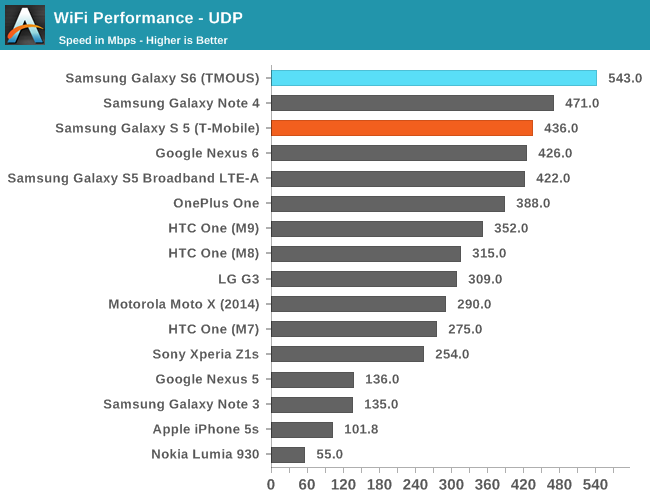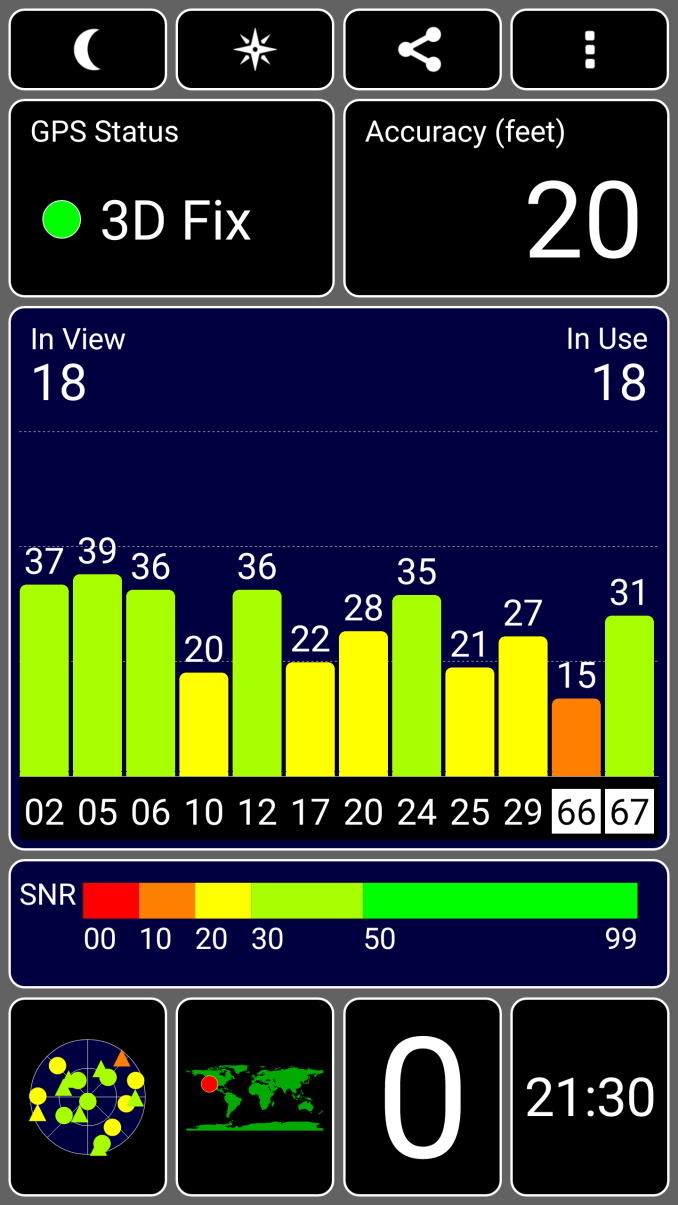The Samsung Galaxy S6 and S6 edge Review
by Joshua Ho on April 17, 2015 9:00 AM EST- Posted in
- Smartphones
- Samsung
- Mobile
- Galaxy S6
- Galaxy S6 Edge
WiFi Performance
As WiFi is still quite important on a smartphone for anyone on a relatively limited data plan, it's also important to test how well a device behaves when using WiFi. In order to do this, we use our standard iperf test to see how fast the device can send UDP packets. In the case of the Galaxy S6, we see that it shares the same BCM4358 WiFi/Bluetooth combo chipset that we first saw in the Galaxy Note 4. As always, in order to ensure maximum possible performance we're using an Asus RT-AC68U router to avoid issues with the router bottlenecking the phone.

As we can see, the Galaxy S6 manages to do better than anything else we've been able to test in recent memory. I'm not sure what's causing the difference in performance when comparing against the Note 4, but it's definitely possible that the antenna configuration has been improved to increase coherence and therefore the performance benefit that comes from MIMO.
GNSS Performance
In most of the Galaxy S6 variants, as there is no Gobi modem that could be used to provide GNSS location services it seems that Samsung has turned to Broadcom to provide satellite location services. In the case of the Galaxy S6, we see a Broadcom BCM4773 location chipset. This includes support for all of the major constellations including GPS, Beidou, and GLONASS in addition to SBAS, which helps to improve accuracy beyond what conventional GPS satellites can provide. To get a good idea for how good this system is I tried testing how long it took for a lock to happen on a clear night with airplane mode on. The Galaxy S6 managed to acquire a lock in 20 seconds which is likely to be a warm lock but a cold lock will likely take a minute without assistance data. After an additional 20 seconds I saw a peak accuracy of 20 feet, so there shouldn't be any notable issues with the GPS system. For the Galaxy S6 CDMA variants it's likely that location will be done using the MDM9x35 Gobi modem rather than the Broadcom solution used in the GSM Galaxy S6.
Misc
For the Galaxy S6, Samsung has fundamentally uprooted how they traditionally design their phones, and in the case of the entire radio architecture this is especially true. Instead of the standard Qualcomm modem, we see that Samsung has moved to the Shannon 333 GSM/LTE modem for the Galaxy S6 GSM variants. Given that this is likely to be the same modem that is in the Note 4 LTE-A it’s likely that this modem will ship as category 6, while we have reason to believe it's ultimately capable of UE category 9. However, whether the RF front-end is capable of handling 3x carrier aggregation of up to 450 Mbps on the downlink is a different question and is likely to be one that we won’t know the answer to unless support is added in an OTA update.
The transceiver, envelope tracker, antenna tuner, and most of the components that would traditionally be Qualcomm parts in a Snapdragon-equipped phone have also been replaced with Samsung Shannon components based upon the Chipworks teardown. In general though, I didn’t notice any issues with this choice of RF components although judging by the use of Qualcomm modems in the CDMA variants it’s likely that such a move was necessary in order to ensure good RF performance on CDMA networks but not GSM networks due to Qualcomm’s experience with CDMA2000. It's likely that anyone that has had previous experience with the CDMA Galaxy Nexus would be able to attest to this.
Unlike some other variants, we’ve noticed that the Galaxy S6 T-Mobile variant uses an Audience eS804 voice processor to enable hot word detection and S-Voice launching and is likely also active in phone calls and in any other scenario where noise cancellation and voice processing would be beneficial. The T-Mobile variant that we received also uses an NXP PN547 NFC module rather than a Samsung NFC module, but we did confirm that there is an ST-M digitizer used for the touchscreen and a Cypress CapSense PSoC for the capacitive keys.
Although I still don’t have the equipment to test speakers properly, subjectively the audio quality of the Galaxy S6’s single downward-firing speaker is good. The volume gets high enough that I never really used it on maximum volume for videos, but it’s still annoying to have to cup my hand to ensure that sound is going towards my face rather than traveling away. Overall the M9 still has much better speakers for a good media experience, but there’s nothing wrong with the speaker on the Galaxy S6 for casual use. I definitely found myself using it less than the front-facing speakers on the M9 though.











306 Comments
View All Comments
itzraywhy - Saturday, April 18, 2015 - link
If this isnt the best smartphone android camera in the market what is?sonicmerlin - Saturday, April 18, 2015 - link
Are you aware that in the COUNTRY benchmarks you mentioned the iPad Air 2 several times but didn't include it in the charts? You even wrote "here we see the Air 2" blah blah except it's not in the chart!sonicmerlin - Saturday, April 18, 2015 - link
Sorry I meant "CPU" benchmarks. Stupid autocorrect.heartinpiece - Sunday, April 19, 2015 - link
Yup, I also pointed that out a few pages(of comments) back.Would be great to see comparisons against the iPad Air 2
JoshHo - Tuesday, April 21, 2015 - link
We're often faced with a dilemma here as inserting comparison devices can lead to a naive reading that we're attempting to directly compare a tablet-class vs smartphone-class SoC when one has a significantly higher TDP. These scores are also available on Bench but we will add them with a note.3ogdy - Sunday, April 19, 2015 - link
Looking at the phone I can very easily state this is an iPhone by Samsung. Leaving the incredibly stupid decisions (no microSD card slot on a high-end phone) and the stupid ones aside (battery is hard to remove), this is one big piece of sh!t. If I wanted an iSh!t, I would've bought one, Sammy. Let CrApple be CrApple, you Korean copycats. I wouldn't be surprised if the Koreans got a deal with the Americans to have the right to use their design papers. This is nearly identical to an iSh!t - look at the edges, at the way the various antennas were integrades, at the grills, the buttons, the SIM cover and the way to remove it.....THIS IS A CrApple product, not a Samsung one.Oh and yes, the SGS5 was ugly as hell and brought nothing new to the table. No progress, no sale. Why would anyone spend money on a phone that's basically the same as its previous generation in terms of tech specs and capabilities, looks a million times worse (including the the version for Gypsies) and costs as if it was a flagship in every possible way?
I couldn't care less about the decisions taken over at Samsung, but I'd love to see these huge "F**k you, customers!" and middle fingers pointed at us reflected in the product sales.
Microsoft did the same thing and they woke up and even posted apologies and stating "We listened." big and clear on their front page. They are about to screw things up with that stupid Windows h8 theme in WIndows 10 again...but keeping in mind how late the XP theme came after XP was first introduced, they are still on schedule.
nerd1 - Sunday, April 19, 2015 - link
Samsung just followed mainstream customers and reviewers (who mostly cared for look and feel), and market seems to quite like sammy's decision.Uplink10 - Sunday, April 19, 2015 - link
Leaving MicroSD card slot is not a mainstream decision but a decision out of greed. It is costlier to buy a phone with bigger memory than to stick in a MicroSD card.jet57 - Sunday, April 19, 2015 - link
h265 encode is mentioned as a capability of the SoC, but does the S6 record video using that codec, in any size? I'm very keen for this as I love the idea of 4K video but have reservations over handling gigantic h264 files that could be half the size if they used h265.jasonb16 - Sunday, April 19, 2015 - link
How's voice quality.